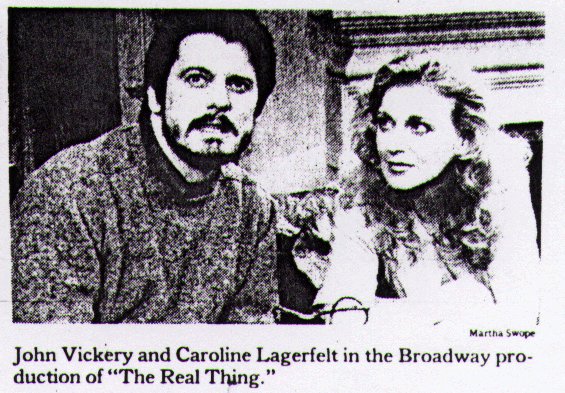New York Times
August 1, 1984
Stage: New Cast in 'The Real Thing'
By FRANK RICH
The hero of Tom Stoppard's ''Real Thing,'' a loquacious playwright named Henry, believes that words can replicate themselves endlessly, ''like a spiral of DNA.'' There are times when one wishes that Mike Nichols, the play's director, could be just as easily cloned; there's no better director of actors in our theater right now. Amazingly, Mr. Nichols has forged three fine acting ensembles in less than a year - the original company of ''The Real Thing,'' that of ''Hurlyburly'' and now the replacement cast that has settled into Mr. Stoppard's hit at the Plymouth.
While the new ''Real Thing'' players aren't always quite up to their predecessors, only a repeat visitor might notice. Mr. Nichols's new cast, which contains no stars but many familiar faces, is a unified, impeccably paced team that delivers the play with style and sensitivity. If a few nuances have disappeared, others have been uncovered - often for better, occasionally for worse.
The crucial role, by far, is Henry, and it is here where Mr. Nichols has made his smartest choice: John Vickery is an equal match for the formidable Jeremy Irons. Mr. Vickery first grabbed attention in Central Park three summers ago, with his sterling Hal in ''Henry IV, Part 1.'' Since then, he has languished in poor or unsuitable roles on and Off Broadway. It's stirring to watch this gifted young artist receive the opportunity he deserves and make the most of it.
Like Mr. Irons, Mr. Vickery effortlessly conveys the urbane, unstoppable erudition of Mr. Stoppard's glib and high-minded protagonist. He lightly disposes of the flippant wisecracks, then brings a religious fervor to the beautiful Act II paean to the sanctity of words. But the real test comes when Henry, having always shielded himself from love in both life and art, must finally succumb to rending romantic passion for the first time. Confronted with the messy emotions of ''the real thing,'' the playwright experiences ''self-knowledge through pain''; even his ''sentence structure goes to pot.'' The hard-edged Mr. Vickery softens in delicate degrees until he is a pale, red-eyed wreck, hiding in a bathrobe and lacing every line with raw hurt. The performance is so lucid that we understand Henry's despair and growth perhaps more fully than we did before.
As Annie, the extramarital lover who is the instrument of the hero's painful awakening, Caroline Lagerfelt is closer in spirit and looks to Felicity Kendal, the role's London originator, than Glenn Close. Miss Lagerfelt's Annie is more a selfish sexpot than a free spirit. Though it takes a while for us to accept her as a love- match for Mr. Vickery's Henry, the actress eventually makes the case in her own distinctive way. Such is the performance's tone, however, that it inevitably calls attention to Mr. Stoppard's uncharitable and at times fuzzy conception of his heroine.
Simon Jones and Sara Botsford, as the spouses Annie and Henry discard, are excellent. In rapid succession, Mr. Jones must carry the play's first funny scene and first upsetting one; his swift transformation from Noel Coward-style roue to pitiful cuckold is dazzling. Anthony Fusco has everything except the electric charge that Peter Gallagher brought to Billy, Annie's young actor friend, but Yeardley Smith, as Henry's daughter, is all snapdragon bite and no heart. Vyto Ruginis, the original cast's one holdover, continues to bring humorous leavening to the misconceived role of a thuggish political playwright.
As one may notice the flaws in Mr. Stoppard's play on another visit, so one also gains renewed respect for its many strengths. For all its entertaining apercus, Pirandellian theatrical tricks and wit, ''The Real Thing'' is an integrally designed piece whose content and form are inseparable. The play is not only about how Henry learns to feel love, but also about how he learns to write about love, which he had previously regarded as ''unliterary.'' Early on, we see a play-within-the-play, a brittle romantic comedy written by Henry; almost every scene that follows is a subtle variation on its hero's script, with each progressive version bringing us closer to the more mature and passionate play that heartache is teaching Henry how to write.
Mr. Stoppard, of course, learned how to write that play, too: As Henry's intricate sentence structure collapses, so ''The Real Thing'' finds the breathing room to accommodate expansive feelings unknown to previous Stoppard works. ''The Real Thing'' is this writer's most affecting play yet, and, as long as Mr. Nichols stays firmly in charge, it's likely to remain one of Broadway's most rewarding evenings.

John Vickery and Caroline Lagerfelt in the Broadway production of "The Real Thing."
Photo credit: Martha Swope |
Play's Still the Thing
THE REAL THING, by Tom Stoppard; directed by Mike Nichols; scenery by Tony Walton; costumes by Anthea Sylbert; lighting by Tharon Musser; sound by Otts Munderloh; production supervisor, Martin Herzer.
Presented by Emanuel Azenberg, The Shubert Organization, Icarus Productions, Byron Goldman, Ivan Bloch, Roger Berlind and Michael Codron. At the Plymouth Theatre, 45th Street, west of Broadway.
| Max | Simon Jones |
| Charlotte | Sara Botsford |
| Henry | John Vickery |
| Annie | Caroline Lagerfelt |
| Billy | Anthony Fusco |
| Debbie | Yeardley Smith |
| Brodie | Vyto Ruginis |

